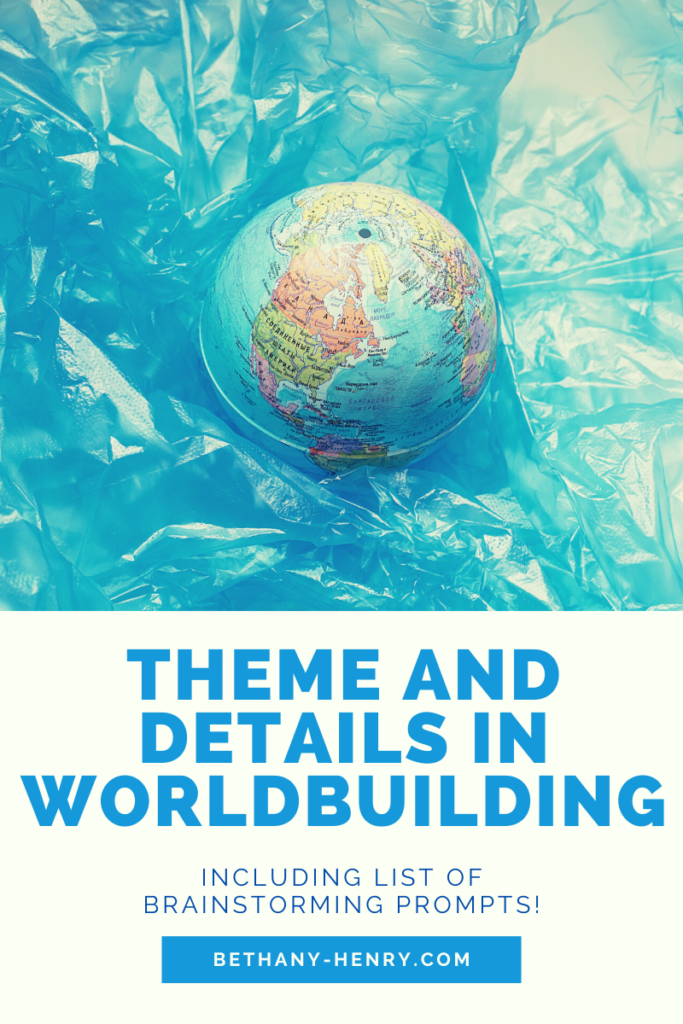
Our worldbuilding is the setting and atmosphere of our stories. As writers, we don’t want to overlook this critical component of making our stories the strongest they can be!
But what makes worldbuilding great? And how do we *do* that?
Today we’ll walk through two aspects of worldbuilding: Theme and Details.
Theme and Details in Worldbuilding
Theme
A theme in worldbuilding refers to the big picture concept that pulls everything together.
There will be lots of different pieces involved in our world but they all should fit into one unified whole, otherwise the story will feel disjointed or unfinished and leave the reader confused. The goal is to create a setting that is cohesive and where its parts work together: suddenly all the different pieces are more than the sum of their parts and we’ve created something more.
Themed worldbuilding results in powerful settings that interest and resonate with readers and can add to the story’s tone and plot.
Aspects of Theme to Consider:
- How things work (technology level, whether there is magic, etc)
- What things look like (aesthetics, style, general trappings)
- What things feel like (tone, atmosphere)
Each of these aspects should work together under our overall theme.
For further reading, check out my post on creating magic systems!
Examples of theme:
Lord of the Rings is a classic example of a widely copied theme: Medieval European fantasy. We have low technology levels and specific magic items and magic users, we have a medieval European flavor of aesthetics, and we have an questing adventure tone that is sometimes serious but includes some lighthearted moments.
If a spaceship or a gun appeared in the story, that would be out of place. If there were absurdist or horror elements introduced, those would also be hard to explain.
Sometimes even if adding a spaceship would make for a really cool scene- we may need to save that bit for a different story in order to keep our story as a cohesive whole.
How to decide what theme is right:
Each of our stories will have different setting requirements- for example, we may have a story that takes place completely in one or two homes or we may have a story that travels across the globe.
Likewise, we may have different ideas of what atmosphere or tone we are looking to create.
Try answering the questions above regarding how things work, what they look like, and what they feel like. This should give us a starting place for the basics of our worldbuilding.
Try thinking outside the box a bit here! Tolkien’s Middle Earth may have been original when he wrote it but at this point it has become pretty standard fare. What can make our worlds fresh and interesting?
Once we have a general idea of our theme we can brainstorm more! I’m very visual so I love to look at pictures of places, people, architecture, and food as I try to think about what things may fit into my story.
We don’t need to write a thesis on our theme, but jotting down a sentence or so about what unified concept we are looking to create can go a long way to strengthen our worldbuilding.
Further brainstorming prompts below!
For further reading, check out this great guide on Mythcreants!

Details
If theme is the big piece pulling our worldbuilding together, then details are the little pieces that flesh it all out.
“Details matter. They create depth, and depth creates authenticity.”
Neil Blumenthal
We want the worldbuilding in our story to have depth and authenticity. While theme is what will unify our worldbuilding, we still need to have the details and descriptions to fill it with.
Examples of details:
Going back to our Lord of the Rings example from before, we can see how the details are what show the different aspects of the worldbuilding. It doesn’t announce: “This story has low technology and includes magic!” Instead it shows the hobbits farming with basic tools and traveling on foot and it shows specific magic users and magical items, each with their own rules and limitations.
These details make the story interesting, easier to visualize, and more believable.
For further reading check out this post on writing good descriptions!
Brainstorming
As we think through our world, there are a lot of pieces that can be included!
Here are some elements to think about both in terms of theme and details.
What could these look like in your world?
- Sports
- Holidays
- Diversity
- Health care
- Music and songs
- Common sayings
- Literature
- Schools
- Public spaces
- Gossip
- Superstitions
- Politics
- Clashing cultures
- Travel
- Immigration
- Employment
- Sending a letter
- Food
- Fashion
- Cliches
- Pets
- Play
- Religion
Don’t forget to have fun! Fill your story with shiny things! Don’t be afraid of trying something a little different or including things you love- chances are other people will love it to. It’s your story! Happy writing! 🙂




